
A liquid-crystal display (LCD) is a flat-panel display or other electronically modulated optical device that uses the light-modulating properties of liquid crystals combined with polarizers. Liquid crystals do not emit light directly, instead using a backlight or reflector to produce images in color or monochrome. LCDs are available to display arbitrary images or fixed images with low information content, which can be displayed or hidden. For instance: preset words, digits, and seven-segment displays, as in a digital clock, are all good examples of devices with these displays. They use the same basic technology, except that arbitrary images are made from a matrix of small pixels, while other displays have larger elements. LCDs can either be normally on (positive) or off (negative), depending on the polarizer arrangement. For example, a character positive LCD with a backlight will have black lettering on a background that is the color of the backlight, and a character negative LCD will have a black background with the letters being of the same color as the backlight. Optical filters are added to white on blue LCDs to give them their characteristic appearance.
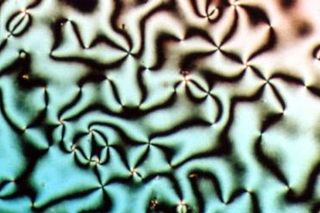
Liquid crystals (LCs) are a state of matter which has properties between those of conventional liquids and those of solid crystals. For instance, a liquid crystal may flow like a liquid, but its molecules may be oriented in a crystal-like way. There are many different types of liquid-crystal phases, which can be distinguished by their different optical properties. The contrasting areas in the textures correspond to domains where the liquid-crystal molecules are oriented in different directions. Within a domain, however, the molecules are well ordered. LC materials may not always be in a liquid-crystal state of matter.
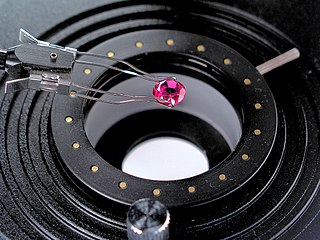
Gemology or gemmology is the science dealing with natural and artificial gemstone materials. It is a geoscience and a branch of mineralogy. Some jewelers are academically trained gemologists and are qualified to identify and evaluate gems.
Supersaturation occurs with a chemical solution when the concentration of a solute exceeds the concentration specified by the value equilibrium solubility. Most commonly the term is applied to a solution of a solid in a liquid. A supersaturated solution is in a metastable state; it may be brought to equilibrium by forcing the excess of solute to separate from the solution. The term can also be applied to a mixture of gases.
Cryobiology is the branch of biology that studies the effects of low temperatures on living things within Earth's cryosphere or in science. The word cryobiology is derived from the Greek words κρῧος [kryos], "cold", βίος [bios], "life", and λόγος [logos], "word". In practice, cryobiology is the study of biological material or systems at temperatures below normal. Materials or systems studied may include proteins, cells, tissues, organs, or whole organisms. Temperatures may range from moderately hypothermic conditions to cryogenic temperatures.

An ingot is a piece of relatively pure material, usually metal, that is cast into a shape suitable for further processing. In steelmaking, it is the first step among semi-finished casting products. Ingots usually require a second procedure of shaping, such as cold/hot working, cutting, or milling to produce a useful final product. Non-metallic and semiconductor materials prepared in bulk form may also be referred to as ingots, particularly when cast by mold based methods. Precious metal ingots can be used as currency, or as a currency reserve, as with gold bars.
Cyril Hilsum CBE FRS FREng HonFInstP is a British physicist and academic.

Professor Sir John Roy Sambles, FRS is an English experimental physicist and a former President of the Institute of Physics.
George William Gray was a Professor of Organic Chemistry at the University of Hull who was instrumental in developing the long-lasting materials which made liquid crystal displays possible. He created and systematically developed liquid crystal materials science, and established a method of practical molecular design. Gray was recipient of the 1995 Kyoto Prize in Advanced Technology.

Martin Schadt is a Swiss physicist and inventor.
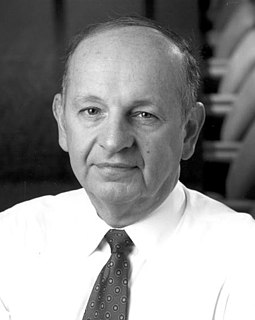
George Harry Heilmeier was an American engineer, manager, and a pioneering contributor to liquid crystal displays (LCDs), for which he was inducted into the National Inventors Hall of Fame. Heilmeier's work is an IEEE Milestone.
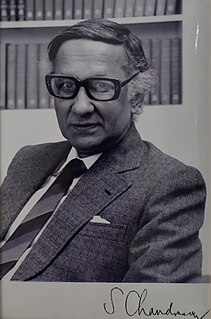
Sivaramakrishna Chandrasekhar FNA, FRS was an Indian physicist who won the Royal Medal in 1994. He was the founder-president of the International Liquid Crystal Society.
Heino Finkelmann is a retired German chemist in the area of liquid-crystalline elastomers.
The British Neuroscience Association (BNA) is a scientific society with around 2,000 members. Established on the 23rd of February 1968 as the Brain Research Association, it was subsequently relaunched as the British Neuroscience Association in 1997.
The Learned Society of Wales is a learned society and charity that exists to "celebrate, recognise, preserve, protect and encourage excellence in all of the scholarly disciplines", and to serve the Welsh nation.
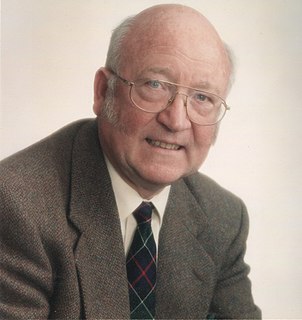
Professor Frank Matthews Leslie FRS FRSE was a Scottish mathematical physicist specializing in continuum mechanics. He is remembered for the Ericksen–Leslie Theory which he developed with Jerald Ericksen to describe the viscosity of mesophases associated with liquid crystals. The parameters of this theory are viscosities called "Leslie coefficients", and the angle at which a nematic orientates with respect to the direction of flow in a steady shear flow is called the "Leslie angle".
Dame Frances Carolyn Saunders is a British scientist and former civil servant. She was the chief executive of Dstl between August 2007 and March 2012. Prior to this Saunders was a policy officer at the Office of Science and Technology and research scientist into liquid crystal devices at the Royal Signals and Radar Establishment. Saunders was the president of the Institute of Physics from 2013 to 2015.

Helen Frances Gleeson OBE FInstP is a British physicist who specialises in soft matter and liquid crystals. She is Cavendish Professor and former Head of the School of Physics at the University of Leeds.
Ranganathan Shashidhar is a US-based Indian condensed matter physicist and a former head of the Laboratory for Molecularly Engineered Materials and Surface of the Center for Biomolecular Science & Engineering, a division of the United States Naval Research Laboratory. Known for his research on liquid crystals, Shashidhar is an elected fellow of the Indian Academy of Sciences and the senior vice president of Polestar Technologies, a US-based company involved in the development of sensing technologies. The Council of Scientific and Industrial Research, the apex agency of the Government of India for scientific research, awarded him the Shanti Swarup Bhatnagar Prize for Science and Technology, one of the highest Indian science awards, for his contributions to Physical Sciences in 1984.
Nelamangala Vedavyasachar Madhusudana is an Indian physicist and an emeritus scientist at Raman Research Institute. Known for his research on liquid crystals, Madhusudhana is an elected fellow of Indian Academy of Sciences and Indian National Science Academy. The Council of Scientific and Industrial Research, the apex agency of the Government of India for scientific research, awarded him the Shanti Swarup Bhatnagar Prize for Science and Technology, one of the highest Indian science awards, for his contributions to physical sciences in 1989.









